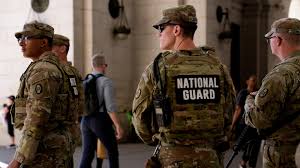
In a provocative speech to hundreds of military leaders gathered at Marine Corps Base Quantico, President Donald Trump called for American cities to become “training grounds” for the military. This was part of his broader campaign to tackle what he labelled as “civil disturbances” in urban areas, describing them as the “enemy from within.”
The President, addressing generals and military officials from around the world, underscored his belief that the situation would not “get out of control” once military forces became involved. This remark came in the wake of Trump’s controversial decision to deploy National Guard troops to various cities, including Washington DC, Los Angeles, and Portland, Oregon, in a crackdown on crime and immigration enforcement.
Trump’s comments, which targeted Democratic-led cities such as Chicago, San Francisco, and Los Angeles, emphasised his continued push for the military to play a larger role in law enforcement, especially in urban areas he claims are “unsafe.” He stated that he intended to address these cities “one by one,” framing the situation as a “war from within” and stressing that controlling the physical borders was crucial for national security.
His remarks drew sharp criticism from Illinois Governor JB Pritzker, who accused Trump of using military resources to “invade and disrupt” US cities, calling the President’s actions “petty” and authoritarian.
Secretary of Defence Pete Hegseth, who also spoke at the summit, unveiled controversial new military fitness standards aimed at removing “woke” culture from the Pentagon. Hegseth called for a return to what he termed a “warrior ethos,” alongside a focus on physical fitness with the introduction of higher “male-level” standards, which he admitted may exclude some women from serving in combat roles.
Hegseth also laid out plans to end what he described as the “era of unprofessional appearances,” which included eliminating exemptions for beards, and vowed to discontinue anonymous complaint procedures. His speech, advocating for a shift away from diversity, equity, and inclusion (DEI) programs, was in line with Trump’s broader focus on restoring military standards
The announcement sparked significant pushback, particularly from military veterans like Illinois Senator Tammy Duckworth. Duckworth criticised the reforms, warning that they would discourage many potential recruits, including women and people of colour, from considering military service. She accused Hegseth of trying to purge underrepresented groups from the armed forces.
While the speech saw little visible reaction from the assembled generals, the few moments of movement came when hundreds of boots snapped to attention as Hegseth and Trump took the stage.
In his address, Trump also revealed plans to rebrand the Department of Defense as the “Department of War,” calling it a “historic reassertion” of American pride and purpose. He claimed that the move had already been popular, even among his critics, and contributed to what he described as skyrocketing recruitment figures.
In addition to his criticisms of the military’s current state, Trump boasted of his foreign policy successes, including the “settling” of seven wars, and expressed hopes of reaching a peace agreement in Gaza if Hamas accepted his proposals.
As the event came to a close, Vice-President JD Vance attempted to downplay the significance of the gathering, suggesting that the media had inflated its importance. However, many analysts, including NATO officials, pointed out that such a large-scale in-person meeting of military leaders was unprecedented.
The summit, which included officers from military bases across the globe, was designed to foster unity within the ranks, according to Trump, who framed the gathering as an opportunity to strengthen “esprit de corps” among the troops.


